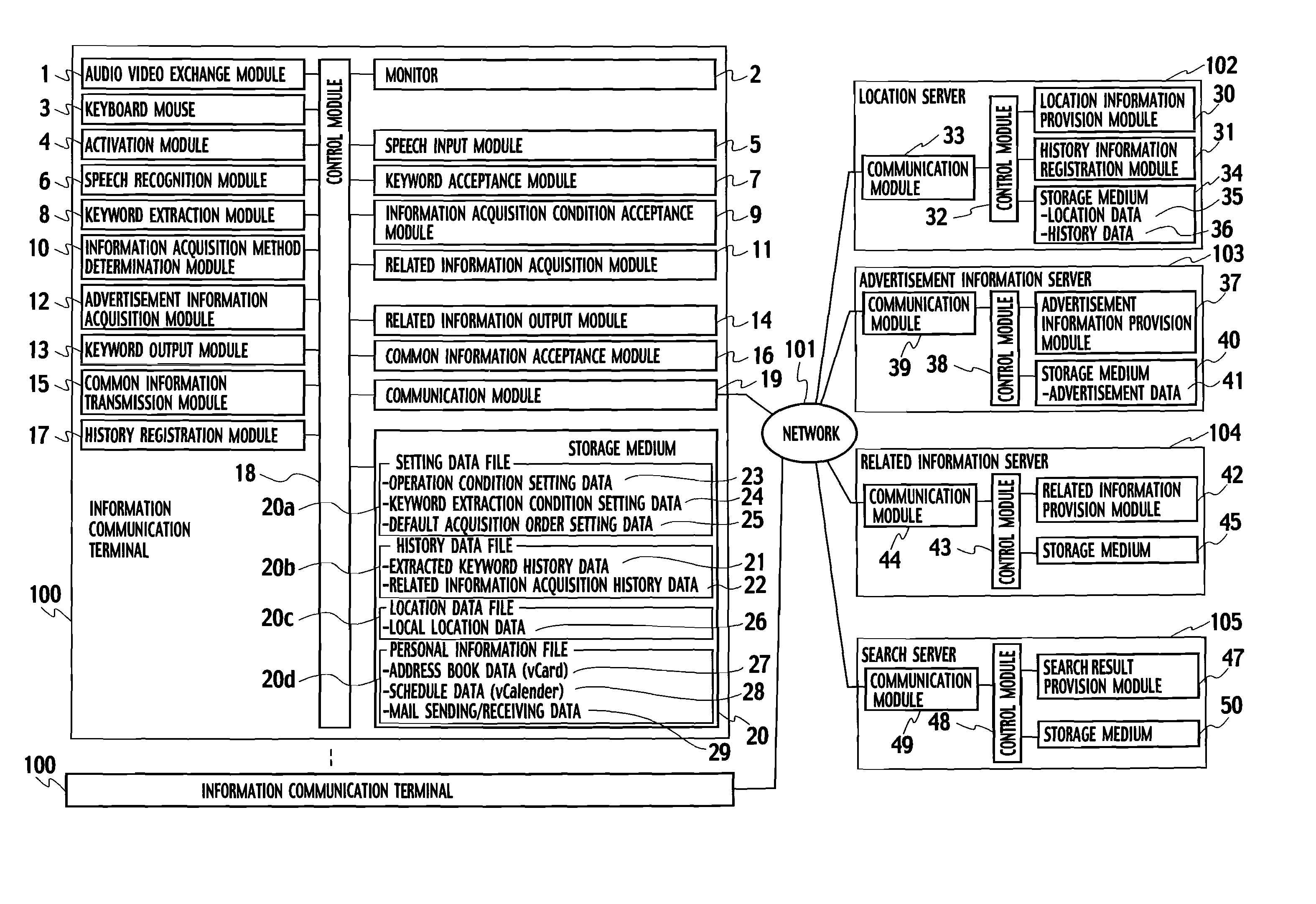Information communication terminal, information communication system, information communication method, information communication program, and recording medium recording thereof
a terminal and information communication technology, applied in the field of information communication terminals, information communication systems, information communication methods, information communication programs, etc., can solve the problems of user inability to select, conventional techniques cannot be applied to communication where terminals, and search of a place where information is stored may require a long tim
- Summary
- Abstract
- Description
- Claims
- Application Information
AI Technical Summary
Problems solved by technology
Method used
Image
Examples
first embodiment
—Description of Entire Structure—
[0144]The information communication system according to a first embodiment of the present invention includes, as shown in FIG. 1, an the information communication terminal 100 including an audio video communication terminal, a related information server 104, a search server 105, a location server 102, and an advertisement information server 103. The respective systems can communicate with each other via a network 101.
[0145]There exists a plurality of information communication terminals 100. The information communication terminal 100 has a function to use the audio video exchange module 1 to provide IP telephone and IPTV telephone functions for providing realtime exchange of audio and video information.
[0146]It is assumed that call control is performed by a specific method based on a protocol (e.g., H.323, SIP). The information communication terminal 100 extracts a keyword from speech information exchanged via an IP telephone or an IPTV telephone to a...
second embodiment
Description of the Entire Structure
[0419]An information communication system according to a second embodiment is different from the information communication system shown in FIG. 1 in that the information communication terminal 100 further includes a speech recognition result exchange module 70.
[0420]When an operation condition setting data 23 (which will be described later) has the speech recognition result transmission necessity set to “1=required”, the speech recognition result exchange module 70 uses the communication module 19 to exchange the word information 62 outputted from the speech recognition module 6 with the information communication terminal 100 of a call party.
[0421]The information communication terminal 100 as a destination is determined based on the speech additional information 61 outputted from the speech recognition module 6. It is assumed that there may be a plurality of information communication terminals 100 as a call party. The speech recognition result exch...
third embodiment
Description of the Entire Structure
[0472]As shown in FIG. 26, an information communication system according to a third embodiment is different from the information communication system shown in FIG. 23 in that the information communication terminal 100 further includes an emotion information processing module 51 and a speech output module 57. The emotion information processing module 51 includes an emotion recognition module 52, an emotion information transmission module 53, an emotion information reception module 54, and an emotion information display module 55.
[0473]The emotion recognition module 52 is a module that identifies, based on speech information acquired from the speech input module 5, an emotion included in the audio to send the emotion as emotion information to the emotion information transmission module 53 and the emotion information display module 55. Emotion information may be, for example, data divided based on ten levels in accordance with delight, anger, sorrow a...
PUM
 Login to View More
Login to View More Abstract
Description
Claims
Application Information
 Login to View More
Login to View More - R&D
- Intellectual Property
- Life Sciences
- Materials
- Tech Scout
- Unparalleled Data Quality
- Higher Quality Content
- 60% Fewer Hallucinations
Browse by: Latest US Patents, China's latest patents, Technical Efficacy Thesaurus, Application Domain, Technology Topic, Popular Technical Reports.
© 2025 PatSnap. All rights reserved.Legal|Privacy policy|Modern Slavery Act Transparency Statement|Sitemap|About US| Contact US: help@patsnap.com



